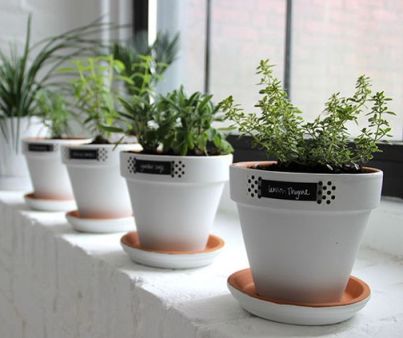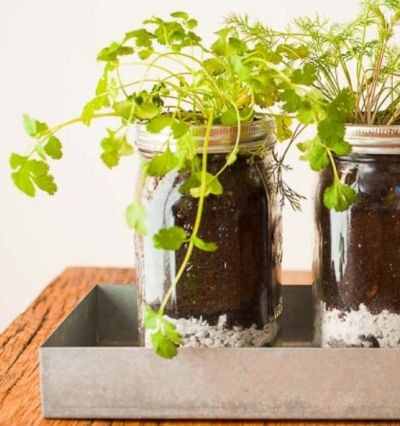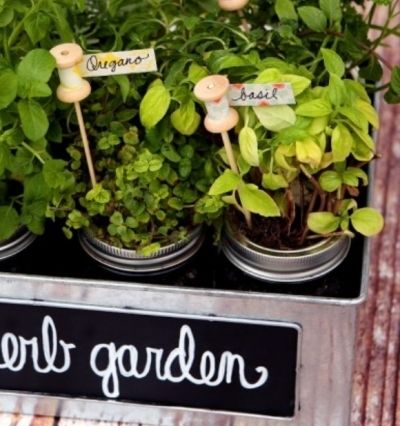You might wonder why a person needs to know what defines plant containers. After all, if it holds some potting mix and doesn’t make a mess on the balcony, windowsill, or floor… we’re good to go. You might be delighted with the scenario. But when was the last time you had a long, heartfelt discussion on the situation with your plants?
“Plants can’t talk!” you say?
Sure they can. You just need to learn how to listen visually. Unfortunately, many people don’t realize that. So, a lot of things that are really poor choices for plant containers get used. You’re unknowingly asking far more from the plants than you would even consider for the same compensation.
Take the trend for planting herbs in mason jars. Yes, it’s cute. Martha no doubt loves the chalkboard labels, twine, and galvanized trays and carriers. Simply perfect for rustic wedding centerpieces and guest gifts, but as long-term herb garden plant containers?
Real plants aren’t crafting supplies. We’re not talking about dried flowers. Live plants have distinct needs. They must grow… as big under the surface as above it.
And if you really pay attention, you’ll see that many of these mason jar garden plants are freshly planted or not doing so well. Like the scraggly, drooping, and yellowed cilantro below. What about the golden oregano and chartreuse basil next to it? If healthy, all these plants are vibrant green! Clearly, these specimens are struggling.
Naturally, enthusiasm is hard after you’re abruptly moved from plant containers larger than the jar your crafty new owner crammed you into. But what do they look like months after the photo shoot? I’m all for creative stuff. Just give me some chalk paint and old furniture with good lines! But I also understand plants. If you’re going to grow them, then put them in plant containers that give them a chance.

Plants need air flow. Not just through the leaves, but for their roots. They need superb drainage (unless they naturally inhabit bogs). Most herbs are dry land plants that grow to rather large proportions. If you want cute plant containers, do something creative with terracotta pots. At least they allow good drainage and some air flow for roots. However, once you paint them a solid color, which requires a sealer to keep the paint from peeling… you no longer have air flow between the top and the drainage hole. Without it diseases like root rot is an accident waiting to happen.
If the container’s walls are solid plastic, resin, glass, or have a non-porous finish (glazing, paint, etc.) the roots start circling the edge of this cage. They’re looking for air and elbow room, and the only place to get it is exiting the drainage hole. Sometimes they get so upset about the lack of space and oxygen, they push their roots above the soil. Not good. They’re just trying to get comfortable with their lot in life.
Yes, terracotta plant containers dry out fast. Why? Because there’s airflow through the walls! And unless you let it stay dry too long, plants grow well in terracotta pots. It’s the reason they’ve been used for centuries. That air flow builds stronger root systems, which is why fabric planters deliver such excellent results.
Putting a little gravel at the bottom gives non-draining plant containers some drainage space. As long as you don’t over water. Being able to see the water level inside a mason jar is easy and gives you a visual guide of when to add more. However, it’s an excellent environment for mold and mildew. The glass also allows sunlight in, which causes algae to grow. Not only does this look icky, it’s not good for your plants.
Why?
Algae hogs any oxygen in that little drainage space. Not that your mason jar planter will have much oxygen in that stagnant depository. But roots need that oxygen. Without it, plants have a difficult time taking in nutrients. It also plays havoc with the pH level. Which is why most forms of hydroponic growing involve aerating the water and nutrient reservoir. It’s also why light cannot penetrate the reservoir and plumbing of a well-built hydroponic system. Because you must choose between growing algae or plants really well.
Repurposing tin cans, teacups, and canning jars as plant containers is trendy. They do work short-term, but they’re only cool in your eyes. Plants need plant containers with more plant-friendly amenities to really thrive. And if you simply MUST have a mason jar herb garden, meet your plants in the middle.
- Stick to wide mouth quart size jars.
- Paint the outside of the jars a dark color.
- Start herbs from seed or disease-free cuttings in 1-inch Rockwool cubes.
- Transplant into 3″ net cups filled with clay pellets from the hydroponic shop.
- Use the Kratky hydroponic method. (No pump needed.)
- Hang your chalkboard plant identification tag.
- Place under a grow light for consistent plant energy.
Don’t overlook the fact that herbs demand full sun to grow well. An LED spot grow light will give leafy plants a lot more food and energy than indirect light from a window or door wall. It’s probably sufficient for plant containers in 12-18 square inches of counter space.
Images courtesy of Little Bits Of, eighteen25, Pass The Pistil, DIY Network via Pinterest (respectively).


Love this. I’ve read so much about succulents in terra cotta pots and can see the huge difference it makes in how happy they are now vs when in plastic. I only use plastic (saucers) for propogating leaf and stem cuttings as they do better with more humidity in the container/soil. Also, use coco coir instead of soil for propogating.
For short term, (like a wedding etc) I wonder if placing a small plastic nursery pot (with a plant in it and appropriate substrate) into a mason jar would work as decoration without harming the plant.
Thoughts?
Thanks for explaining that plant containers allow for airflow around the roots. I want to start growing plants outdoors. You helped me see why buying pottery would be worth it! https://www.hanoverconcrete.com/planters